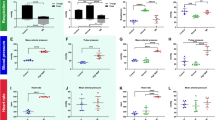Abstract
Vascular permeability in cranial nerve roots was examined after intravenous injection of sodium fluorescein in the adult rabbit. Fluorescence was observed in the distal nerves through the following portions: intracavernous portion of the oculomotor nerve, distal internal auditory camal segment of the facial nerve, and ganglionic portions of the trigeminal, glossopharyngeal and vagus nerves. In the acoustic nerve, the vestibular ganglion showed fluorescence. No fluorescence was observed in the olfactory or optic nerves. During in vivo gadolinium-enhanced magnetic resonance imaging (Gd-MRI) of two separate animals, trigeminal nerve enhancement was observed in the region showing fluorescence. Histologically, intense fluorescence was observed in ganglia and external nerve sheaths of the cranial nerves showing macroscopic fluorescence. A slight fluorescence was also seen in endoneurial connective tissue but not observed within the nerve fibers. The results of this study suggest that the physiological enhancement of human cranial nerves seen on Gd-MRI may correlate with vascular permeability.
Similar content being viewed by others
References
Aaborg TM (1980) Fluorescein angiography. Principles and practice of ophthalmology. Saunders, Philadelphia, pp 905–929
Gabarski SS, Telian. SA, Niparko JK (1992) Enhancement along the normal facial nerve in the facial canal: MR imaging and anatomic correlation. Radiology 183:391–394
Gamble HL (1964) Comparative electromicroscopic observations on the connective tissues of a peripheral nerve and a spinal nerve root in the rat. J Anat 98:17–25
Haller FR, Low FN (1971) The fine structure of the peripheral nerve root sheath in the subarachnoid space in the rat and other laboratory animals. Am J Anat 131:1–19
Hulstrom D, Malmgren LT, Dilstring D, Olsson Y (1983) FITC-Dextran as tracers for macromolecular movements in the nervous system. Acta Neuropathol (Berl) 59:53–62
Kilgore DP, Breger RK, Daniels DL, Pojunas KW, Williams AL, Haughton VM (1986) Cranial tissues: normal MR appearance after intravenous injection of Gd-DTPA. Radiology 160:757–761
Malmgren LT, Olsson Y (1980) Differences between the peripheral and the central nervous system in permeability to sodium Fuorescein. J Comp Neurol 191:103–119
Millen SJ, Daniel DL, Meyer GA (1990) Gadolinium-enhanced magnetic resonance imaging in facial nerve lesions. Otolaryngol Head Neck Surg 102:26–33
Olsson Y (1990) Microenvironment of the peripheral nervous system under normal and pathological condition. Crit Rev Neurobiol 5:265–311
Schwaber MK, Larson TC, Zealear DL, Creasy J (1990) Gadolinium-enhanced magnetic resonance imaging in Bell's palsy. Laryngoscope 100:1264–1269
Waksman BH (1961) Experimental study of diphtheritic polyneuritis in the rabbit and guinea pig: the blood-nerve barrier in the rabbit. J Neuropathol Exp Neurol 20:35–77
Author information
Authors and Affiliations
Rights and permissions
About this article
Cite this article
Nakao, Y., Sakihama, N., Matshumoto, K. et al. Vascular permeability to sodium fluorescein in the rabbit cranial nerve root: possible correlation with normal cranial nerve enhancement on gadolinium-enhanced magnetic resonance imaging. Eur Arch Otorhinolaryngol 251, 457–460 (1994). https://doi.org/10.1007/BF00175995
Received:
Accepted:
Issue Date:
DOI: https://doi.org/10.1007/BF00175995




